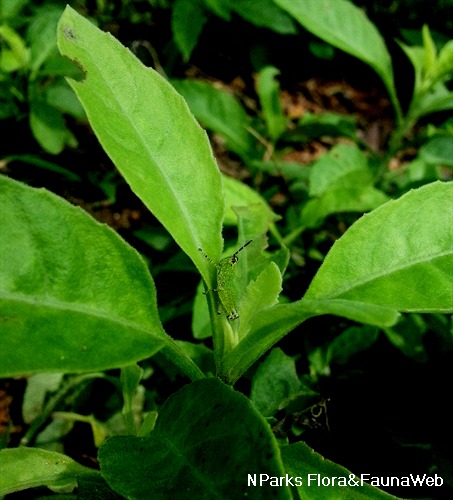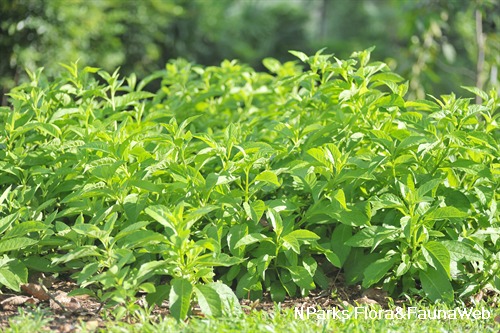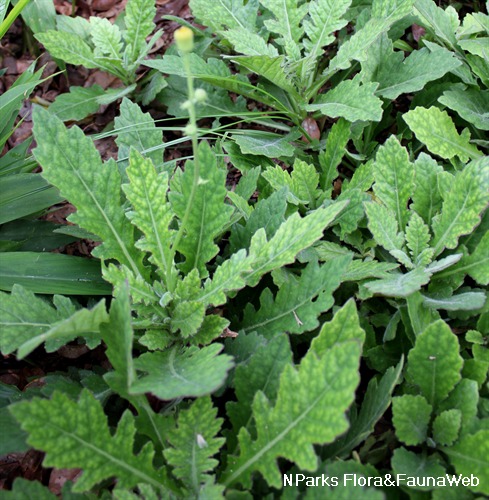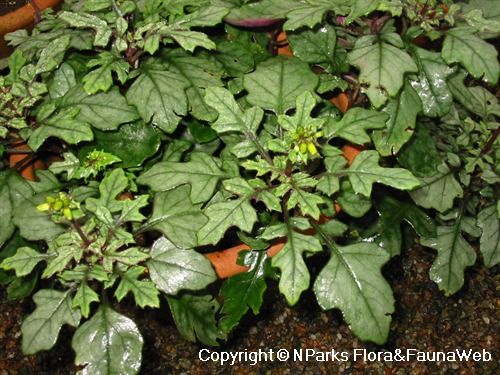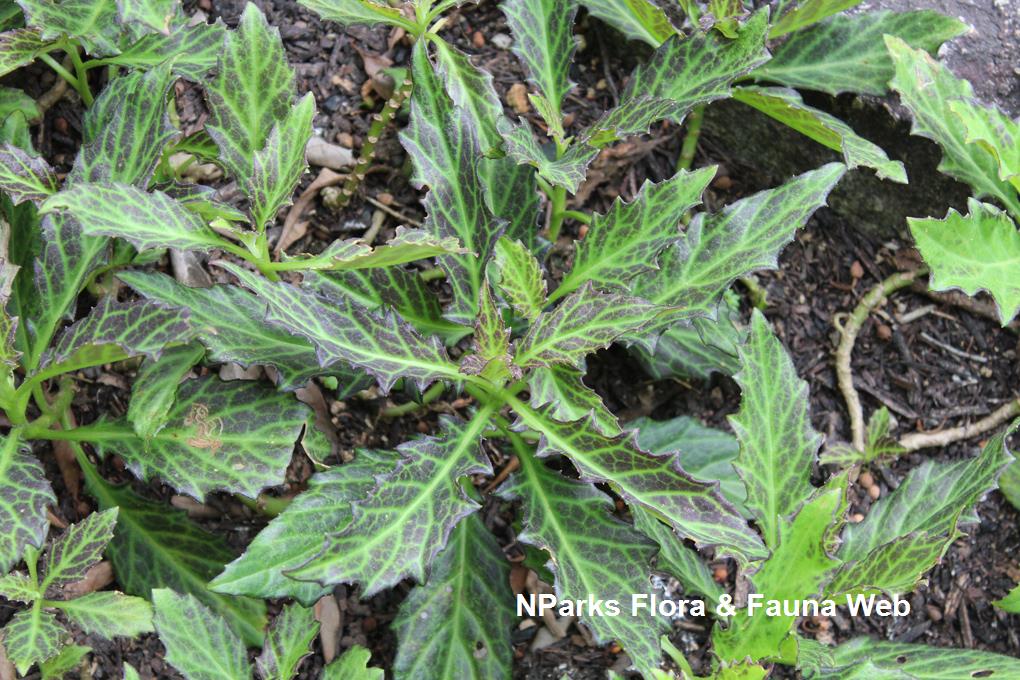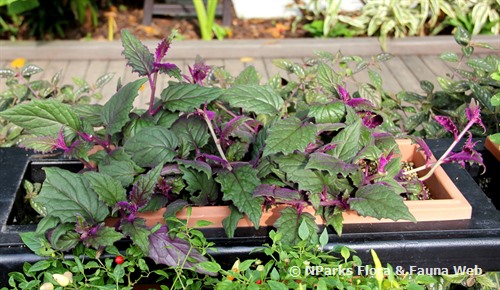
Back
Gynura procumbens
| Family Name: | Asteraceae (Compositae) |
| Common Name: | Longevity Spinach, Scrambling Gynura, Sambung Nyawa, Cholesterol Spinach, 平卧菊三七, 尖凤尾, 南非叶 |
Name
Classifications and Characteristics
| Plant Division | Angiosperms (Flowering Seed Plants) (Dicotyledon) |
|---|---|
| Plant Growth Form | Herbaceous Plant |
| Lifespan (in Singapore) | Perennial |
| Mode of Nutrition | Autotrophic |
Biogeography
| Native Distribution | Malaysia |
|---|---|
| Native Habitat | Terrestrial |
| Preferred Climate Zone | Tropical |
| Local Conservation Status | Native to Singapore (Critically Endangered (CR)) |
Description and Ethnobotany
| Growth Form | It is a small perennial herb with a growth of about 1 - 3 m in height. It has a scandent (climbing) growth habit. |
|---|---|
| Foliage | Smooth, fleshy leaves are round to ovate and lanceolate with shallow teeth along the leaf margin. Leaf blades measure up to 8 cm long and 3.5 cm wide; purplish on the underside while greenish on the upper surface; glabrous (smooth), base rounded or attenuate, apex acute to acuminate. |
| Stems | The stems are fleshy, and has purple or have purple spots. |
| Flowers | An orange, dense and clustered inflorescence (capitula) in corymb, on terminal or axillary stem, with long and slender peduncles. |
| Habitat | Naturally found by the streams in the forests, and sandy slope areas. |
| Cultivation | It can be propagated via stem cutting. Grow in a well-drained soil. |
| Etymology | The genus Gynura means female-tail which refers to the elongated stigma. The specific epithet procumbens means lying flat on the ground, or creeping forwards, in reference to the growth habit. |
| Ethnobotanical Uses | Edible Plant Parts : Edible Leaves Food (Fruit or Vegetable): In Java and Malaysia, the leaves are consumed raw as a vegetable. Medicinal: Scientific Evidence of Medicinal Properties In pre-clinical trials, Longevity Spinach showed pain-relieving (Akter et al., 2019), anti-cancer (Ghofur et al., 2015), anti-diabetic (Zhang et al., 2000), anti-inflammation (Wong et al., 2015), antioxidant (Nazri et al., 2019), cholesterol-lowering properties (Nazri et al., 2019) and anti-malarial properties (Wong et al., 2015) in animals. Traditional Medicinal Uses Research supports the traditional use of Longevity Spinach to treat diabetes. Other traditional uses include using it to treat fever, kidney ailments and dysentery. In Singapore, some Chinese use the leaves to lower blood pressure. It is important to note that some therapeutic effects from traditional medicinal uses of plants are not currently supported or verified by scientific research. Others: The leaves are used in cooking in Thailand. |
Landscaping Features
| Landscape Uses | Parks & Gardens, Small Gardens, Container Planting |
|---|
Plant Care and Propagation
| Light Preference | Semi-Shade |
|---|---|
| Water Preference | Moderate Water |
| Rootzone Tolerance | Well-Drained Soils |
| Propagation Method | Seed, Stem Cutting |
Foliar
| Foliage Retention | Evergreen |
|---|---|
| Mature Foliage Colour(s) | Green |
| Mature Foliage Texture(s) | Smooth |
| Prominent Young Flush Colour(s) | Green |
| Young Flush Texture(s) | Smooth |
| Foliar Type | Simple / Unifoliate |
| Foliar Attachment to Stem | Petiolate |
| Foliar Shape(s) | Non-Palm Foliage (Ovate, Oval, Lanceolate) |
| Foliar Venation | Pinnate / Net |
| Foliar Margin | Serrate / Toothed |
| Foliar Apex - Tip | Acute, Acuminate |
| Foliar Base | Cuneate, Rounded / Obtuse |
Floral (Angiosperm)
| Flower Colour(s) | Orange |
|---|---|
| Flower Grouping | Cluster / Inflorescence |
| Flower Location | Axillary, Terminal |
| Inflorescence Type | Corymb |
| Flowering Period | Free-Flowering |
References
| References | Akter, L., Sultana, S. & Hossain, M.L. (2019). Assessment of analgesic and neuropharmacological activity of ethanol leaves extract of Gynura procumbens (Family: Asteraceae) Journal of Medicinal Plants Studies 7(5): 52–56. Ghofur, A., Hamid, I.S. & Listyorini, D. (2015). Anti-carcinogenic activity of Gynura procumbens extract through cytochrome P450 and glutathione s-transferase. International Journal of PharmTech Research 8(1): 24–29. Nazri, K.A.A., Fauzi, N.M., Buang, F., Saad, Q.H.M., Husain, K., Jantan, I. & Jubri, Z. (2019). Gynura procumbens standardised extract reduces cholesterol levels and modulates oxidative status in postmenopausal rats fed with cholesterol diet enriched with repeatedly heated palm oil. Evidence-based Complementary and Alternative Medicine Article ID 7246756. Wong, S.K., Jann, M.L.S., Sudi, S., Hassan, W.R.B.M., Chin, L.P., Embi, N. & Sidek, H.M. (2015). Anti-malarial and anti-inflammatory effects of Gynura procumbens are mediated by kaempferol via inhibition of glycogen synthase kinase-3β (GSK3β). Sains Malaysiana 44(10): 1489–1500. Zhang, X.F. & Tan, B.K.H. (2000). Effects of an ethanolic extract of Gynura procumbens on serum glucose, cholesterol and triglyceride levels in normal and streptozotocin-induced diabetic rats. Singapore Medical Journal 41(1): 9–13. |
|---|
Image Repository
Others
| Master ID | 29936 |
|---|---|
| Species ID | 4245 |
| Flora Disclaimer | The information in this website has been compiled from reliable sources, such as reference works on medicinal plants. It is not a substitute for medical advice or treatment and NParks does not purport to provide any medical advice. Readers should always consult his/her physician before using or consuming a plant for medicinal purposes. |

